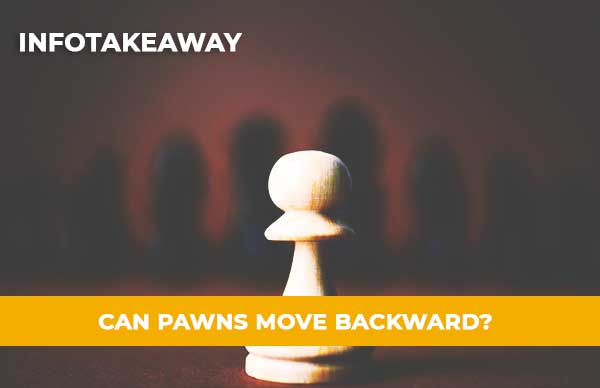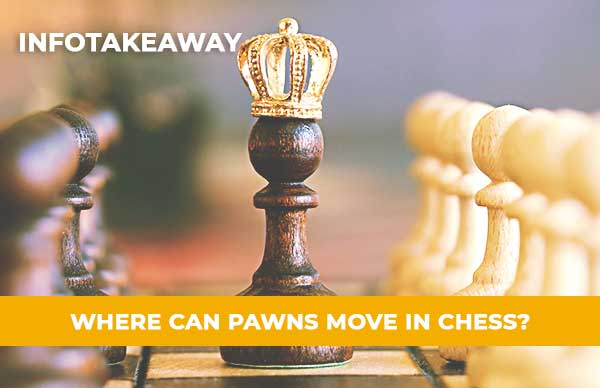A pawn is one of the most basic chess pieces, and you may have wondered, “can pawns move backwards?”.
In the chess game, a pawn can move forward or backward just one square at a time, but it cannot move sideways. Only the player’s rook, bishop, and queen can move any number of squares on any given turn.
The Pawn is the only piece that can capture an enemy piece by moving over it to take it off the board.
The Pawn is also a powerful piece whose strength lies in numbers. At the same time, the alone king may be able to get away in all directions, and the Pawn can still overpower it by occupying unoccupied squares.

Can Pawns Move Backwards In Chess?
Pawns cannot move backward in a chess game; they can only move forward on the chessboard.
Pawns are given special moves at the beginning of a chess game.
A pawn can move two steps ahead at the start of a game, but afterward, it is only allowed to a single square forward at a time. Using pawns efficiently is a very good game of skill.
This means that Pawns can move two squares on the first turn only, and then, they can only move one square at a time.
The capture rule of Pawns states that they can capture enemy pieces diagonally in front of them that are one square apart.
Can Pawns Capture Backwards In Chess?

Pawns cannot capture backward in Chess because the rules of Chess do not allow it.
It Doesn’t matter whether you are using a black pawn or a white pawn.
Both black Pawn and white Pawn can never move backward.
The Rook (Castle) and the Knight can move in any direction, including backward. The Bishop moves on diagonals.
The Pawn moves forward only. A player cannot move a pawn back to its original position.
There is one way you can transform your Pawn to other pieces once you reach the end of the chessboard.
Where Can Pawns Move In Chess?

In Chess, Pawns can only move forward, and they cannot go back.
Whenever the opponent piece is directly in front of a pawn diagonally, then the Pawn can move diagonally in front to left or right.
Only one can move forward in the case of two pawns on the same line. If a pawn reaches the last row of the board, it can promote to any piece that has not been taken.
Also, note that if there is a piece right in front of your Pawn, you cannot move that Pawn.
What Is En Passant In Chess?

The french word En Passant means passing or “in the passing.”
En passant is a special move-in Chess that occurs when a pawn moves two squares forward and is immediately captured by an enemy pawn.
In simple terms, suppose that an enemy pawn is sitting two squares ahead of your pawn on the starting line.
If you move your Pawn two steps and your Pawn is now on the same row as the enemy pawn, the enemy pawn can move diagonally behind your Pawn, and doing so will eliminate your Pawn that moved two steps.
The reason for this move is that originally, pawns could only move one step at a time, even at the start of a game.
Later on, pawns were enabled to move two steps on the first move.
Another thing to remember is that En passant is allowed only on the very next turn after a pawn moves two steps ahead.
What Is Pawn Promotion In Chess?
Pawn promotion is the act of a pawn reaching the eighth rank and being able to be promoted to any piece. The most common type of pawn promotion is when a pawn reaches the eighth rank and can be promoted to a queen.
The other possibility is that a pawn reaches the opposite end of the board and is promoted to any piece other than the queen. This is called underpromotion.
Also, keep in mind that promotion can only occur if a rook piece, bishop piece, queen piece, and knight piece has been eliminated. Therefore, Pawn is a valuable piece in Chess.
You cannot have extra queens at the same time. Also, note that you cannot promote a pawn to a king piece.
FAQs
There are many common questions related to pawn chess pieces, such as “can pawns move backwards,” is pawn a valuable piece, or how many pawns are there. We have compiled the most commonly asked questions related to pawns below.
Is It Wise To Sacrifice Pawns In Chess?
Pawns are often be used as sacrifices in Chess. The most common type of sacrifice is the pawn sacrifice. A player gives up a pawn to achieve some advantage, such as development or attack.
For example, you can sacrifice your Pawn and use the bishop piece as an attacking piece to capture an enemy piece.
You can use additional pieces and pawns to create a cunning strategy that will make your game very interesting. As you can see, Pawn is not a boring piece.
Pawn sacrifices are usually notated with an exclamation mark when documenting.
Can Pawns Move Diagonally Backwards?
No, Pawns cannot move in any direction other than forwards. A pawn cannot move diagonally backwards in Chess as the rules have never allowed it.
Pawns only move forward one step at a time, but they can move two steps ahead on the first turn. Pawn is still a very dangerous piece in Chess as it allows a capturing piece to eliminate the enemy if used as a sacrifice.
Do Pawns Ever Capture Backwards?
Pawns never capture backward as they are only able to move forward.
You can promote your Pawn to other pieces once you reach the end of the board, and only then can you move backwards. Pawns are not fanciful pieces, but if used correctly, they are the correct piece to turn the whole chess game.
Conclusion – Can Pawns Move Backwards
Pawn is one of the most basic pieces in Chess, and many have wondered can pawns move backwards?
There is a popular misconception that pawns can move in any direction, including backward. This is not true.
Pawns are unable to move backward until reaching their final destination on the chessboard.
Once a pawn reaches the final square, it can be promoted to other pieces such as rook, Bishop, queen, or knight.
After a pawn has been promoted, it can move backward, but a simple pawn can never go back. It only moves forwards.
It doesn’t matter if you are using a black square or a white square, the rules of the pawns are the same.
Pawns are the basic unit in every classic game of Chess.
Pawn is the favorite piece of any veteran chess player because it is the best helper piece in Chess.
It lets you confuse the opposing piece by playing different strategies such as en passant, sacrifice, and promotion.
You can capture the enemy’s square by using these innocent little pawns, so never take them lightly as they are one of the most powerful pieces in Chess.
You will also enjoy our other articles such as “payment revision needed“, “what is a parcel locker“, and “how much do baby elephants weigh“